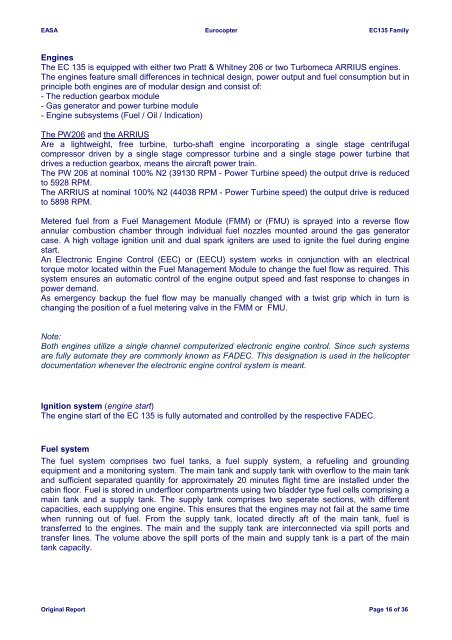Final report EC 135 Family-23 07 12 - EASA
Final report EC 135 Family-23 07 12 - EASA
Final report EC 135 Family-23 07 12 - EASA
You also want an ePaper? Increase the reach of your titles
YUMPU automatically turns print PDFs into web optimized ePapers that Google loves.
<strong>EASA</strong> Eurocopter <strong>EC</strong><strong>135</strong> <strong>Family</strong><br />
Engines<br />
The <strong>EC</strong> <strong>135</strong> is equipped with either two Pratt & Whitney 206 or two Turbomeca ARRIUS engines.<br />
The engines feature small differences in technical design, power output and fuel consumption but in<br />
principle both engines are of modular design and consist of:<br />
- The reduction gearbox module<br />
- Gas generator and power turbine module<br />
- Engine subsystems (Fuel / Oil / Indication)<br />
The PW206 and the ARRIUS<br />
Are a lightweight, free turbine, turbo-shaft engine incorporating a single stage centrifugal<br />
compressor driven by a single stage compressor turbine and a single stage power turbine that<br />
drives a reduction gearbox, means the aircraft power train.<br />
The PW 206 at nominal 100% N2 (39130 RPM - Power Turbine speed) the output drive is reduced<br />
to 5928 RPM.<br />
The ARRIUS at nominal 100% N2 (44038 RPM - Power Turbine speed) the output drive is reduced<br />
to 5898 RPM.<br />
Metered fuel from a Fuel Management Module (FMM) or (FMU) is sprayed into a reverse flow<br />
annular combustion chamber through individual fuel nozzles mounted around the gas generator<br />
case. A high voltage ignition unit and dual spark igniters are used to ignite the fuel during engine<br />
start.<br />
An Electronic Engine Control (E<strong>EC</strong>) or (E<strong>EC</strong>U) system works in conjunction with an electrical<br />
torque motor located within the Fuel Management Module to change the fuel flow as required. This<br />
system ensures an automatic control of the engine output speed and fast response to changes in<br />
power demand.<br />
As emergency backup the fuel flow may be manually changed with a twist grip which in turn is<br />
changing the position of a fuel metering valve in the FMM or FMU.<br />
Note:<br />
Both engines utilize a single channel computerized electronic engine control. Since such systems<br />
are fully automate they are commonly known as FAD<strong>EC</strong>. This designation is used in the helicopter<br />
documentation whenever the electronic engine control system is meant.<br />
Ignition system (engine start)<br />
The engine start of the <strong>EC</strong> <strong>135</strong> is fully automated and controlled by the respective FAD<strong>EC</strong>.<br />
Fuel system<br />
The fuel system comprises two fuel tanks, a fuel supply system, a refueling and grounding<br />
equipment and a monitoring system. The main tank and supply tank with overflow to the main tank<br />
and sufficient separated quantity for approximately 20 minutes flight time are installed under the<br />
cabin floor. Fuel is stored in underfloor compartments using two bladder type fuel cells comprising a<br />
main tank and a supply tank. The supply tank comprises two seperate sections, with different<br />
capacities, each supplying one engine. This ensures that the engines may not fail at the same time<br />
when running out of fuel. From the supply tank, located directly aft of the main tank, fuel is<br />
transferred to the engines. The main and the supply tank are interconnected via spill ports and<br />
transfer lines. The volume above the spill ports of the main and supply tank is a part of the main<br />
tank capacity.<br />
Original Report Page 16 of 36

















